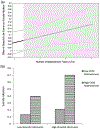Child maltreatment, recent stressful life events, and suicide ideation: A test of the stress sensitivity hypothesis
- PMID: 33444849
- PMCID: PMC7880899
- DOI: 10.1016/j.chiabu.2020.104926
Child maltreatment, recent stressful life events, and suicide ideation: A test of the stress sensitivity hypothesis
Abstract
Background: Exposure to child maltreatment is a well-known risk factor for suicide ideation among adolescents. Recent stressful life events may also contribute to this risk. However, the association between these risk factors is unclear in the etiology of suicide ideation for adolescents from socio-economically disadvantaged backgrounds.
Objective: The present study tested the stress generation and stress sensitivity hypotheses in relation to child maltreatment, recent stressful life events (in the past year), and suicide ideation (in the past two weeks).
Participants and setting: We utilized a sample of diverse, socioeconomically disadvantaged, depressed adolescent girls (N = 175) who were part of a depression treatment intervention.
Results: Child maltreatment was significantly associated with adolescent suicide ideation, β = .40, p < .001. Results supported the stress sensitivity hypothesis, in that exposure to interpersonal stressors in the past year exacerbated the association between child maltreatment and adolescents' suicide ideation, β = .18, p < .05. We found evidence for a protective factor, cognitive reappraisal, in the association between stressful life events and suicide ideation, β = -.15, p < .05.
Conclusions: These findings have several implications for clinical practice and suicide prevention with adolescent girls, and contribute to the extant literature on the role of chronic and acute stress in the etiology of adolescent suicide ideation.
Keywords: Adolescence; Child maltreatment; Depression; Stressful life events; Suicidal ideation.
Copyright © 2020. Published by Elsevier Ltd.
Figures



Similar articles
-
Mother-Daughter Interpersonal Processes Underlying the Association Between Child Maltreatment and Adolescent Suicide Ideation.Suicide Life Threat Behav. 2019 Oct;49(5):1232-1240. doi: 10.1111/sltb.12522. Epub 2018 Oct 17. Suicide Life Threat Behav. 2019. PMID: 30328155 Free PMC article.
-
Proximally-occurring life events and the first transition from suicidal ideation to suicide attempt in adolescents.J Affect Disord. 2018 Dec 1;241:499-504. doi: 10.1016/j.jad.2018.08.059. Epub 2018 Aug 14. J Affect Disord. 2018. PMID: 30149338
-
Childhood trauma, stressful life events, and suicidality in Danish psychiatric outpatients.Nord J Psychiatry. 2020 May;74(4):280-286. doi: 10.1080/08039488.2019.1702096. Epub 2019 Dec 13. Nord J Psychiatry. 2020. PMID: 31833427
-
Association of Recent Violence Encounters With Suicidal Ideation Among Adolescents With Depression.JAMA Netw Open. 2023 Mar 1;6(3):e231190. doi: 10.1001/jamanetworkopen.2023.1190. JAMA Netw Open. 2023. PMID: 36862413 Free PMC article.
-
Are stressful life events prospectively associated with increased suicidal ideation and behaviour? A systematic review and meta-analysis.J Affect Disord. 2020 Apr 1;266:731-742. doi: 10.1016/j.jad.2020.01.171. Epub 2020 Jan 28. J Affect Disord. 2020. PMID: 32217256
Cited by
-
An integrated review of social information processing as a mechanism in the association between maltreatment and depression among youth of color.Child Abuse Negl. 2023 Jan;135:105956. doi: 10.1016/j.chiabu.2022.105956. Epub 2022 Nov 29. Child Abuse Negl. 2023. PMID: 36459888 Free PMC article. Review.
-
Childhood adversities and suicidal ideation among young adults with serious mental illnesses: The mediating roles of perceived stress, dispositional hope, and mental health hope.J Affect Disord. 2025 Jan 1;368:820-828. doi: 10.1016/j.jad.2024.09.095. Epub 2024 Sep 17. J Affect Disord. 2025. PMID: 39299587
-
The association between recent stressful life events and brain structure: a UK Biobank longitudinal MRI study.Eur Psychiatry. 2025 Jan 21;68(1):e18. doi: 10.1192/j.eurpsy.2025.2. Eur Psychiatry. 2025. PMID: 39834263 Free PMC article.
-
Suicidal ideation and behavior among perinatal women and their association with sleep disturbances, medical conditions, and known risk factors.Front Psychiatry. 2023 Jan 19;13:987673. doi: 10.3389/fpsyt.2022.987673. eCollection 2022. Front Psychiatry. 2023. PMID: 36741562 Free PMC article.
-
The association between nation-level social and economic indices and suicide rates: A pilot study.Front Sociol. 2023 Mar 31;8:1123284. doi: 10.3389/fsoc.2023.1123284. eCollection 2023. Front Sociol. 2023. PMID: 37066069 Free PMC article.
References
-
- Beck JS, Beck AT, Jolly JB, & Steer RA (2005). Beck youth inventories for children and adolescents manual (2nd ed.). PsychCorp.
-
- Bernstein DP, & Fink L (1998). Childhood trauma questionnaire: A retrospective self-report: Manual. Psychological Corporation.
Publication types
MeSH terms
Grants and funding
LinkOut - more resources
Full Text Sources
Other Literature Sources
Medical
Miscellaneous

